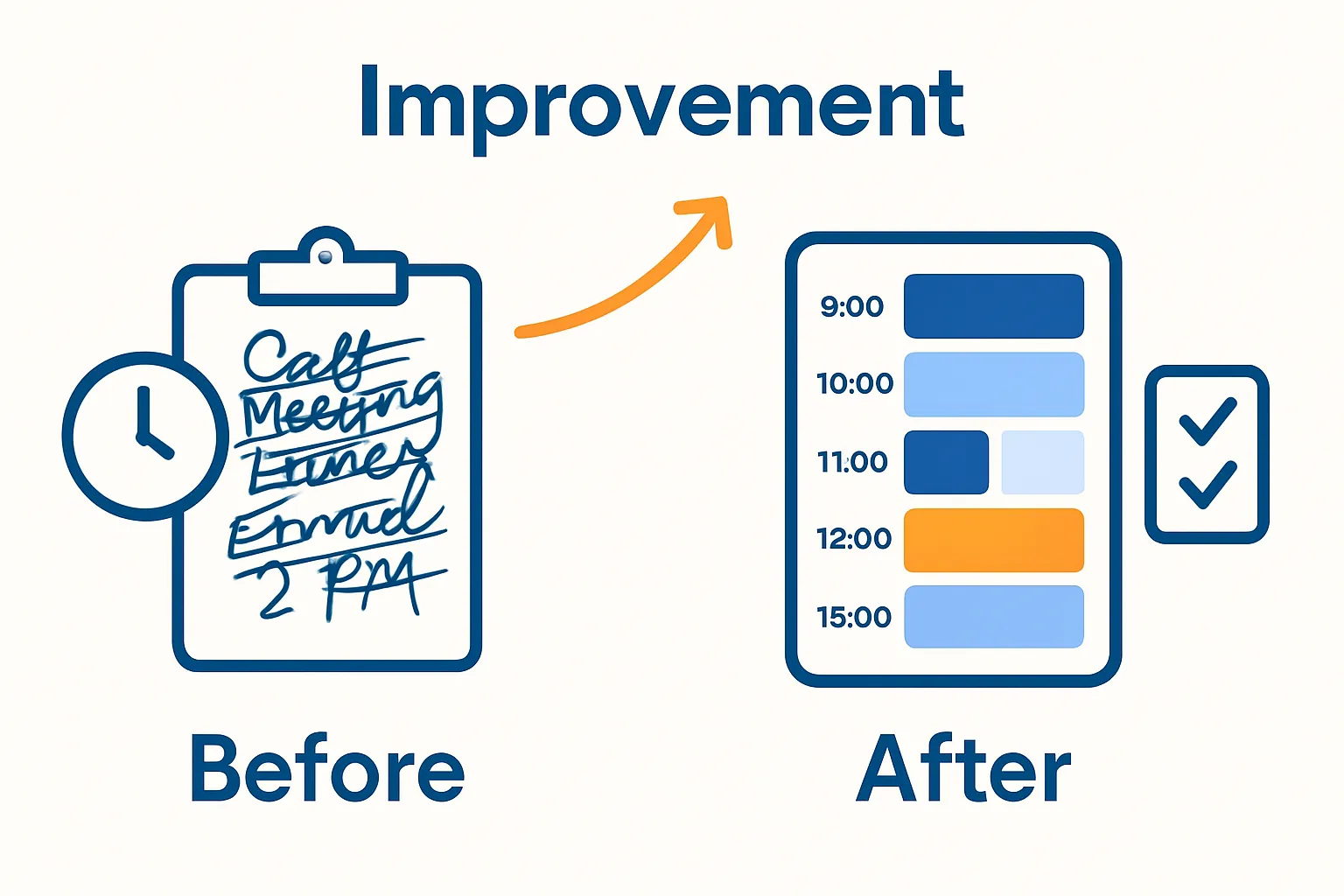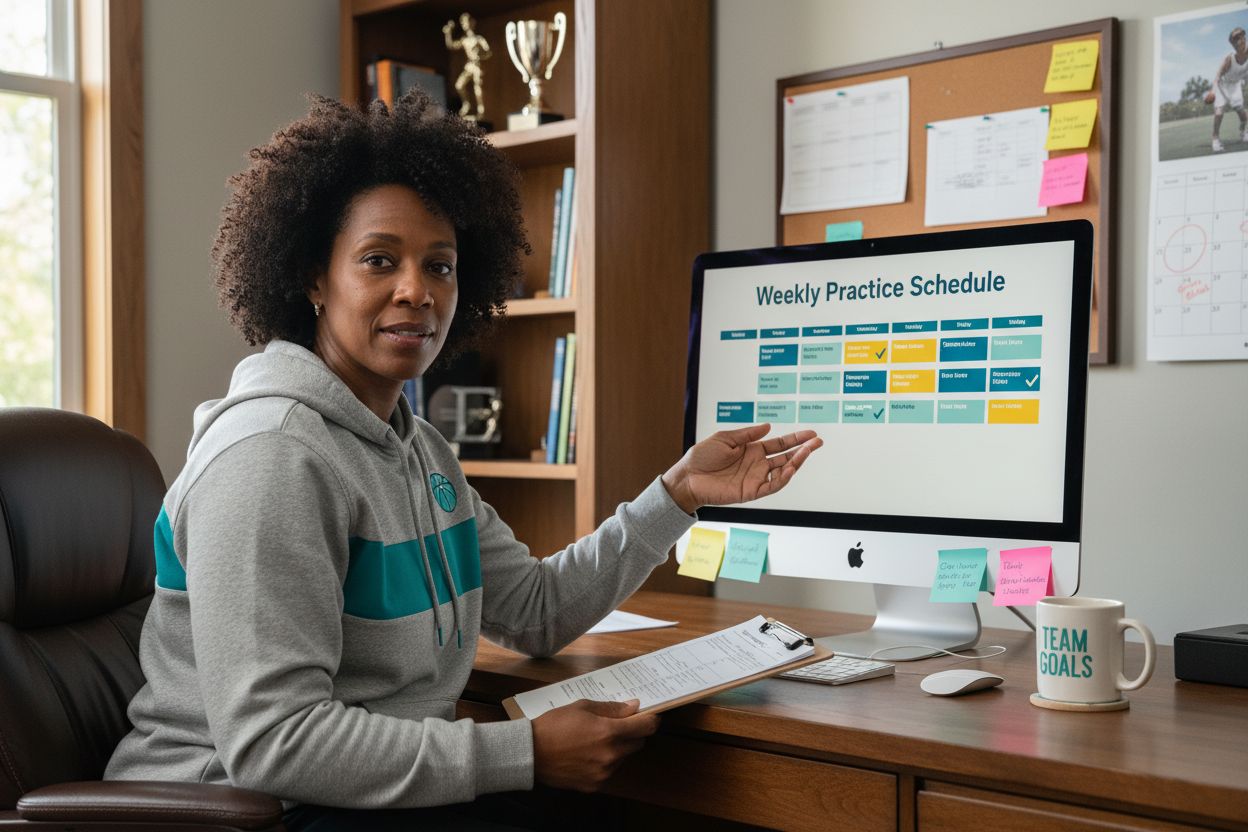Managing time as a basketball coach often feels like juggling a dozen things at once, from intense training sessions to endless paperwork. Research from the American Psychological Association shows that comprehensive time tracking can uncover up to 20 percent of hidden inefficiencies in your work week. Most coaches focus on squeezing more hours out of their day and just hope things will get better. Oddly enough, the secret is not cramming more tasks in—it is about completely rethinking how you spend each minute.
Table of Contents
- Step 1: Evaluate Your Current Time Usage
- Step 2: Prioritize Coaching Responsibilities
- Step 3: Develop A Weekly Practice Schedule
- Step 4: Set Clear Goals For Each Session
- Step 5: Monitor And Adjust Your Time Management
- Step 6: Reflect And Optimize Your Coaching Time
Quick Summary
| Key Point | Explanation |
|---|---|
| 1. Track Your Time for Awareness | Use a detailed time log to identify where your time is spent and discover inefficiencies in your coaching routine. |
| 2. Prioritize Tasks Using the Eisenhower Matrix | Classify your responsibilities into urgent and important categories to focus on high-impact coaching activities. |
| 3. Create a Structured Weekly Practice Schedule | Design a balanced practice plan allocating time for skill development, strategy, and mental preparation. |
| 4. Set Clear Goals for Each Session | Define specific, measurable objectives for practices to enhance player development and track progress effectively. |
| 5. Regularly Reflect and Optimize Your Time | Conduct quarterly reviews to refine your coaching methods and improve time management continuously. |
Step 1: Evaluate Your Current Time Usage
Effective time management for coaches begins with understanding how you currently spend your working hours. Self-awareness is the foundation of transforming your productivity. By meticulously analyzing your daily activities, you can identify time drains, optimize your workflow, and create strategic improvements in your coaching practice.
Start by tracking every activity for an entire week using a detailed time log. According to the American Psychological Association, comprehensive time tracking reveals hidden inefficiencies and patterns that often go unnoticed. Use a digital tool like a spreadsheet or time tracking app to record your activities in 15-minute increments. Document everything from practice planning and player consultations to administrative tasks and personal development time.
As you record your activities, categorize them into primary groups such as direct coaching, administrative work, player development, team strategy, and personal professional growth. This categorization will help you understand where your time is truly being allocated. Pay special attention to activities that consume significant time but provide minimal value to your coaching objectives.
This table compares the primary categories of coaching activities discussed in the time-tracking step, helping coaches quickly identify high-value versus low-value tasks for better time allocation.
| Activity Category | Description | Value to Coaching Objectives |
|---|---|---|
| Direct Coaching | Working directly with players on skills, practice, and feedback | High |
| Administrative Work | Paperwork, scheduling, compliance, and logistics | Low to Moderate |
| Player Development | Individual goal setting, consultations, and performance reviews | High |
| Team Strategy | Game preparation, tactical planning, and analysis | High |
| Personal Professional Growth | Learning, research, and skills improvement for the coach | Moderate |
After completing your time log, conduct a critical analysis. Look for patterns of procrastination, unnecessary meetings, redundant tasks, or time spent on low-priority activities. Identify specific moments where you can streamline processes or delegate responsibilities. Perhaps you spend excessive time on paperwork that could be automated or handling tasks that an assistant could manage more efficiently.
The goal of this evaluation is not to criticize yourself but to create a clear, objective snapshot of your current time usage. By understanding your existing workflow, you can make informed decisions about restructuring your schedule and implementing more effective time management strategies for your coaching practice.
The following table provides an overview of the six main steps for mastering time management as a coach, highlighting the core focus and intended outcome for each stage.
| Step | Main Focus | Intended Outcome |
|---|---|---|
| 1. Evaluate Current Time Usage | Track and categorize all activities | Identify inefficiencies and workflow patterns |
| 2. Prioritize Coaching Responsibilities | Use Eisenhower Matrix for task prioritization | Focus on high-impact, high-priority coaching tasks |
| 3. Develop Weekly Practice Schedule | Structure practice sessions with defined blocks | Ensure systematic team and player development |
| 4. Set Clear Goals for Each Session | Define specific objectives for practices | Drive intentional skill growth and track progress |
| 5. Monitor and Adjust Time Management | Regular self-assessment with tracking tools | Refine strategies and improve efficiency |
| 6. Reflect and Optimize Coaching Time | Conduct quarterly in-depth reviews | Convert insights into actionable optimizations |

Step 2: Prioritize Coaching Responsibilities
After evaluating your current time usage, the next critical step in mastering time management for coaches is strategically prioritizing your coaching responsibilities. Not all tasks carry equal weight in developing a successful basketball program, and learning to distinguish between urgent and important activities will dramatically improve your overall effectiveness.
Begin by creating a comprehensive hierarchy of your coaching responsibilities using the Eisenhower Matrix method. This approach categorizes tasks into four quadrants: urgent and important, important but not urgent, urgent but not important, and neither urgent nor important. For a basketball coach, this might mean prioritizing player skill development and team strategy over administrative paperwork. Player development and direct coaching interventions should always take precedence over less critical activities.
Consider developing a color-coded task management system that visually represents your priorities. Red could signify immediate and critical coaching interventions like addressing team performance issues or preparing for an upcoming crucial game. Green might represent long-term developmental activities such as individual player skill training or strategic team building. Our guide on essential tips for first-time basketball coaches provides additional insights into structuring your coaching priorities effectively.
Implement a weekly planning session where you review and adjust your priorities. During this time, assess your upcoming commitments, game schedules, practice requirements, and player development needs. Allocate your most productive hours to tasks that directly impact team performance and player growth. This might mean scheduling intense skill training sessions during your peak energy times and reserving administrative work for periods when your mental energy is naturally lower.
Remember that prioritization is not about doing more tasks but about focusing on the right tasks at the right time. By consciously directing your energy toward high-impact coaching activities, you create a more streamlined and effective approach to team development and performance improvement.
Step 3: Develop a Weekly Practice Schedule
Creating a structured weekly practice schedule is the cornerstone of effective time management for basketball coaches. A well-designed practice plan transforms sporadic training into a systematic approach for team and player development. This step requires careful consideration of team goals, individual player needs, and strategic progression throughout the season.
Begin by establishing a consistent framework that allocates specific time blocks for different training components. Divide your weekly practice schedule into targeted segments that address skill development, team strategy, physical conditioning, and mental preparation. Rotate focus areas to ensure comprehensive player growth while preventing training monotony. For instance, dedicate certain days to offensive skill work, others to defensive techniques, and include specialized sessions for individual player improvements.
Our Game Preparation Guide with Weekly Practice Plan provides an excellent template for coaches looking to optimize their scheduling approach. When designing your schedule, consider the physical and mental rhythm of your players. Build in recovery periods and vary training intensity to maintain engagement and prevent burnout. High-energy drills should be balanced with technical skill refinement and strategic discussion sessions.
Technology can be a powerful ally in schedule management. Use digital tools like shared team calendars or specialized coaching apps that allow you to track practice progression, player performance, and schedule adjustments in real-time. These platforms enable you to create visual timelines, set specific training objectives for each session, and maintain transparent communication with your entire coaching staff and players.
The most effective practice schedules remain flexible yet structured. Build in buffer time for unexpected developments, individual player consultations, or necessary tactical adjustments. At the end of each week, review your practice schedule’s effectiveness.
 Assess whether you achieved the intended training objectives, identify areas for improvement, and make data-driven modifications to continuously refine your coaching approach.
Assess whether you achieved the intended training objectives, identify areas for improvement, and make data-driven modifications to continuously refine your coaching approach.
Step 4: Set Clear Goals for Each Session
Establishing precise, actionable goals for each coaching session transforms random practice into purposeful skill development. Successful coaching is about intentional, targeted improvement, not simply going through the motions. By defining clear objectives before each practice, you create a roadmap that guides player progression and maximizes limited training time.
Start by developing a goal-setting framework that breaks down team and individual performance targets into specific, measurable components. These objectives should cascade from your broader seasonal strategy, ensuring each practice session contributes meaningfully to overall team development. Consider goals that address multiple dimensions of player performance: technical skills, tactical understanding, physical conditioning, and mental resilience.
For example, instead of a vague goal like “improve shooting,” create a precise objective such as “Develop team’s catch-and-shoot accuracy by 15% through targeted perimeter drills and video analysis.” This specificity allows you to track progress, adjust training methods, and provide concrete feedback. Learn more about developing leadership skills in basketball players to understand how goal-setting contributes to player growth beyond physical skills.
Implement a structured documentation process for your session goals. Use a digital tracking system or coaching journal to record intended objectives, actual performance outcomes, and reflective notes. This practice creates accountability and allows you to identify patterns in team and individual player development. At the conclusion of each practice, conduct a brief review to assess goal achievement. Were the objectives met? What obstacles emerged? What adjustments are necessary for future sessions?
Remember that goal-setting is a dynamic process. Goals should be challenging yet attainable, pushing players beyond their current capabilities while maintaining motivation. Communicate these objectives clearly to your team, ensuring everyone understands the purpose behind each drill and training activity. By making goals transparent and collaborative, you transform practice from a routine exercise into a purposeful journey of continuous improvement.
Step 5: Monitor and Adjust Your Time Management
Time management is not a static process but a dynamic, continuously evolving approach that requires regular evaluation and strategic refinement. Successful coaches understand that flexibility and self-reflection are crucial to maintaining an effective time management system. Implementing a structured monitoring process allows you to identify strengths, address weaknesses, and adapt your strategies to changing team dynamics and personal performance requirements.
According to the American Psychological Association, regular review of your time management strategies is essential for sustained productivity. Develop a monthly self-assessment routine where you critically analyze your coaching performance, time allocation, and overall effectiveness. Use quantitative and qualitative metrics to measure your progress. This might include tracking practice efficiency, player skill development rates, team performance improvements, and your personal stress levels.
Create a comprehensive dashboard or tracking system that provides real-time insights into your time management effectiveness. Utilize digital tools that allow you to log activities, measure time spent on different coaching responsibilities, and generate visual reports of your productivity. These tools can help you identify patterns of time waste, recognize your most productive periods, and make data-driven decisions about schedule optimization.
Implement a feedback loop that involves input from multiple perspectives. Engage with assistant coaches, players, and administrative staff to gain holistic insights into your time management approach. Their observations can reveal blind spots in your current system and provide valuable recommendations for improvement. Be open to constructive criticism and view it as an opportunity for professional growth.
Remember that adjusting your time management strategy is not about achieving perfection but about continuous improvement. Some weeks will be more challenging than others, and your approach must remain flexible. At the end of each month, conduct a comprehensive review. Celebrate the strategies that worked well, analyze the areas that need improvement, and be prepared to make bold, strategic adjustments to your coaching and time management approach.
Step 6: Reflect and Optimize Your Coaching Time
Reflection transforms routine coaching into a strategic, continuously improving practice. The most successful coaches view their time management not as a fixed system, but as a living, adaptable approach that evolves with their team’s needs. This final step is about deep introspection, systematic analysis, and intentional optimization of your coaching time and energy.
According to Harvard Business School research, periodic self-review enables professionals to discover and eliminate time-wasting habits. Implement a comprehensive quarterly review process where you dissect every aspect of your coaching time. Analyze your practice logs, performance metrics, and personal notes to identify patterns of high productivity and potential inefficiencies. Look beyond surface-level time tracking and dig into the qualitative impact of how you spend your coaching hours.
Consider investing in professional tools that can streamline your reflection process. Our Basketball Template Bundle for Coaches provides structured frameworks for performance evaluation and time optimization. During your reflection, ask critical questions: Which coaching strategies yielded the most significant player improvements? Where did you feel most and least energized during practices? What administrative tasks consistently drain your time without proportional value?
Develop a systematic approach to converting insights into actionable improvements. Create a personal optimization roadmap that outlines specific changes to your coaching methodology. This might involve delegating certain administrative tasks, redesigning practice structures, or investing in technology that reduces manual workload. Be ruthless in eliminating activities that do not directly contribute to team and player development.
Remember that optimization is a continuous journey, not a destination. Embrace a growth mindset that views each reflection as an opportunity for refinement. Share your insights with assistant coaches and trusted mentors, creating a collaborative environment of professional development. By consistently reviewing, analyzing, and adjusting your approach, you transform time management from a rigid schedule into a dynamic, responsive system that propels your coaching effectiveness to new heights.
Take Control of Your Coaching Minutes with Proven Basketball Templates
Struggling to implement the time management steps you just read about? Many coaches find that evaluating their schedule and setting clear priorities is only half the battle. The real challenge comes when you need practical tools to cut down on wasted hours, organize practices with intention, and stay focused on player development instead of endless paperwork. Our Basketball Templates at Hoop Mentality solve exactly these pain points by giving you pre-built practice plans, game prep frameworks, and tracking sheets that align with the strategies outlined in this guide.

Ready to boost your efficiency and free up more time for coaching what matters most? Visit https://hoopmentality.com now or check out our Bestsellers to find the resources trusted by top coaches. Start building a more organized and effective coaching system today before another season passes you by.
Frequently Asked Questions
How can I effectively track my time as a coach?
To effectively track your time, maintain a detailed time log for an entire week, recording all activities in 15-minute increments. Use digital tools like spreadsheets or time tracking apps to categorize your tasks, making it easier to identify inefficiencies and optimize your workflow.
What is the Eisenhower Matrix, and how can it help me prioritize coaching tasks?
The Eisenhower Matrix is a time management tool that categorizes tasks into four quadrants: urgent and important, important but not urgent, urgent but not important, and neither urgent nor important. This method helps coaches focus on high-impact responsibilities, such as player development and strategic planning.
How should I structure my weekly practice schedule as a coach?
Structure your weekly practice schedule by allocating specific time blocks for different training components like skill development, team strategy, and conditioning. Ensure to rotate focus areas and consider the players’ physical and mental rhythm, integrating recovery periods and varying training intensity to maintain engagement.
What are some best practices for setting goals during coaching sessions?
When setting goals for coaching sessions, create specific, measurable objectives that align with your overall seasonal strategy. Use a framework that includes technical skills, tactical understanding, and physical conditioning. Document these goals for accountability and review their achievement at the end of each session.
Recommended
- Essential Tips for First-Time Basketball Coaches - Hoop Mentality
- Basketball Template Bundle For Coaches - Hoop Mentality
- 7 Basketball Playbook Must-Haves for Coaches – Hoop Mentality
- Season Preparation Checklist For Basketball Coaches - Hoop Mentality
- Understanding the Role of Time Management in Success – Optio Station: Best Project Management App for Prioritization

